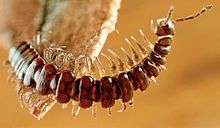Polydesmida
| Polydesmida | |
|---|---|
 | |
| Apheloria virginiensis | |
| Scientific classification | |
| Kingdom: | Animalia |
| Phylum: | Arthropoda |
| Subphylum: | Myriapoda |
| Class: | Diplopoda |
| Superorder: | Merocheta Cook, 1895 |
| Order: | Polydesmida Leach, 1815[1] |
| Suborders | |
| |
| Synonyms | |
|
Proterospermatophora Verhoeff, 1900 | |
Polydesmida (from the Greek poly "many" and desmos "bond") is the largest order of millipedes, containing approximately 3,500 species,[2] including all the millipedes reported to produce hydrogen cyanide (HCN).[3]
Description
Members of the order Polydesmida are also known as "flat-backed millipedes", because on most species, each body segment has wide lateral keels known as paranota.[4] These keels are produced by the posterior half (metazonite) of each body ring behind the collum.[5] Polydesmids have no eyes, and vary in length from 3 to 130 mm (0.12 to 5.12 in).[6] Including the telson, adults have 19 or 20 rings, while juveniles may have from 7 to 19 rings.[5] Mature males have a single pair of gonopods consisting of the modified forward leg pair of the 7th segment.[7] Many of the larger species show bright coloration patterns which warn predators of their toxic secretions.[7]
Ecology
Polydesmids are very common in leaf litter, where they burrow by levering with the anterior end of the body.[4]
Classification
The c. 3500 species of Polydesmida are variously classified into four suborders (names ending in "-idea"), and 28 families, the largest (numerically) including Paradoxosomatidae, Xystodesmidae, and Chelodesmidae.[2]
- Dalodesmidea Hoffman, 1980. 2 families
- Dalodesmidae Cook, 1896
- Vaalogonopodidae Verhoeff, 1940
- Leptodesmidea Brölemann, 1916. 13 families
- Chelodesmoidea Cook, 1895
- Chelodesmidae Cook, 1895
- Platyrhacoidea Pocock, 1895
- Aphelidesmidae Brölemann, 1916
- Platyrhacidae Pocock, 1895
- Rhachodesmoidea Carl, 1903
- Rhachodesmidae Carl, 1903
- Tridontomidae Loomis & Hoffman, 1962
- Sphaeriodesmoidea Humbert & de Saussure, 1869
- Campodesmidae Cook, 1896
- Holistophallidae Silvestri, 1909
- Sphaeriodesmidae Humbert & de Saussure, 1869
- Xystodesmoidea Cook, 1895
- Eurymerodesmidae Causey, 1951
- Euryuridae Pocock, 1909
- Gomphodesmidae Cook, 1896
- Oxydesmidae Cook, 1895
- Xystodesmidae Cook, 1895
- Paradoxosomatidea Daday, 1889.[lower-alpha 1] 1 family
- Paradoxosomatidae Daday, 1889
- Polydesmidea Pocock, 1887. 12 families
- Oniscodesmoidea Simonsen, 1990
- Dorsoporidae Loomis, 1958
- Oniscodesmidae DeSaussure, 1860
- Pyrgodesmoidea Silvestri, 1896
- Ammodesmidae Cook, 1896
- Cyrtodesmidae Cook, 1896
- Pyrgodesmidae Silvestri, 1896
- Haplodesmoidea Cook, 1895
- Haplodesmidae Cook, 1895
- Opisotretoidea Hoffman, 1980
- Opisotretidae Hoffman, 1980
- Polydesmoidea Leach, 1815
- Cryptodesmidae Karsch, 1880
- Polydesmidae Leach, 1815
- Trichopolydesmoidea Verhoeff, 1910
- Fuhrmannodesmidae Brölemann, 1916
- Macrosternodesmidae Brölemann, 1916
- Nearctodesmidae Chamberlin & Hoffman, 1958
- Trichopolydesmidae Verhoeff, 1910
| Representative diversity of Polydesmida | ||||||||||||
|---|---|---|---|---|---|---|---|---|---|---|---|---|
|
References
- ↑ synonym: Strongylosomatidea Brölemann, 1916
- ↑ Robert Mesibov (2005). "A new genus of millipede (Diplopoda: Polydesmida: Dalodesmidae) from Tasmania with a pseudo-articulated gonopod telopodite" (PDF). Zootaxa. 1064: 39–49.
- 1 2 Shear, W (2011). Zhang, Z.-Q., ed. Class Diplopoda de Blainville in Gervais, 1844. In: Animal biodiversity : an outline of higher-level classification and survey of taxonomic richness (PDF). Zootaxa. pp. 159–164. ISBN 978-1-86977-850-7.
- ↑ Thomas Eisner (2005). "Vinegaroons and other wizards". For Love of Insects. Harvard University Press. pp. 44–73. ISBN 978-0-674-01827-3.
- 1 2 Colin Little (1983). "Onychophorans and myriapods". The Colonisation of Land: Origins and Adaptations of Terrestrial Animals. Cambridge University Press. pp. 127–145. ISBN 978-0-521-25218-8.
- 1 2 J. Gordon Blower (1985). "Order Polydesmida". Millipedes: Keys and Notes for the Identification of the Species. Issue 35 of Synopses of the British Fauna (2nd ed.). Brill Publishers. pp. 192–221. ISBN 978-90-04-07698-3.
- ↑ William H. Robinson (2005). "Other arthropods in the urban environment". Handbook of Urban Insects and Arachnids. Cambridge University Press. pp. 389–440. ISBN 978-0-521-81253-5.
- 1 2 Shelley, Rowland M. (1999). "Centipedes and Millipedes with Emphasis on North American Fauna". The Kansas School Naturalist. 45 (3): 1–16.
External links
 Data related to Polydesmida at Wikispecies
Data related to Polydesmida at Wikispecies Media related to Polydesmida at Wikimedia Commons
Media related to Polydesmida at Wikimedia Commons- External Anatomy of Polydesmida
- North American Polydesmida - BugGuide
.jpg)

.jpg)
.jpg)
